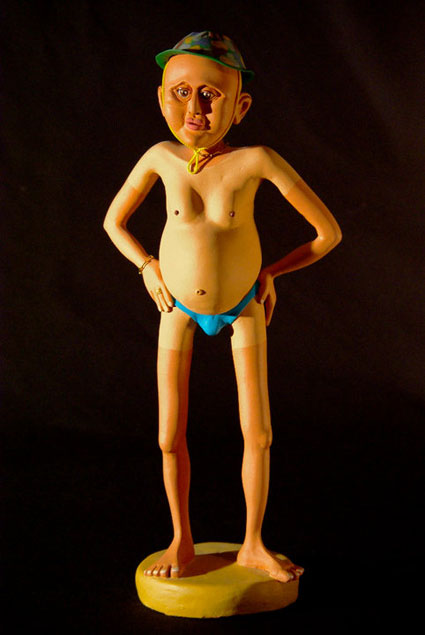Nadine Debien
The World's Theatre
Throughout her work as an artist, from her early paintings to her complex and jarring later compositions, Nadine Debien has preserved an essential feature: the taste for provocation, laughter, and caricature. In having chosen to give life to the tragicomic characters that populate her work-- literally extracting them from out of the canvas-- the artist has also managed to simplify her thought and style, and furthermore, give her work the depth and impact that only the medium of sculpture could enable.
The world's Theatre
“It is really a kind of automatism that makes us laugh... To realize this more fully, it need only be noted that a comic character is generally comic in proportion to his ignorance of himself. The comic person is unconscious.” Henri Bergson, Laughter: An Essay on the Meaning of Comic
By entitling this series of characters “Humanoids,”1 Nadine Debien not only highlights the difference between her works from their models, but she brings to light what constitutes the comic essence-- for what makes us laugh in external appearance is never about similarity or mimesis. It is quite the contrary: it is always through an effort of simplification-- by grasping a detail, expression, or gesture, the artist seizes the comic potentiality of her model.
In her piece "The big head" (La grosse tête), or even in another piece, ironically entitled "The Future" (L’avenir), what matters is not so much if we can recognize the real person who inspired the work, so much as we perceive in them an impact that is not only satirical, but universal. Much like in a Molière play in which the heroes exist purely in their shortcomings (i.e. The Miser, The Affected Ladies, etc.), Nadine Debien concentrates the expressiveness of her “humanoids” in a typifying feature that carries them to an archetypal standing.
Taken as a whole, these works form a kind of kaleidoscopic portrait of our times, specifically, perhaps, through Weber-esque ideal types that our epoch has produced without being aware of it. This is why art, here, should therefore be considered not just as a means of expressing emotions, but rather as an instrument or tool that serves movement, and life. It is an antidote to the clichés that govern us-- asking us to look upon banality with lucidity and compassion. Here, art gives us the strength to laugh at and, perhaps, even to disassociate from convention.

“Laughter must be... a sort of social gesture. By the fear which it inspires, it restrains eccentricity, keeps constantly awake and in mutual contact certain activities of a secondary order which might retire into their shell and go to sleep, and, in short, softens down whatever the surface of the social body may retain of mechanical inelasticity.” Henri Bergson, Laughter: An Essay on the Meaning of Comic
Frédéric-Charles Baitinger
Nadine Debien
www.nadinedebien-plasticienne.com/
